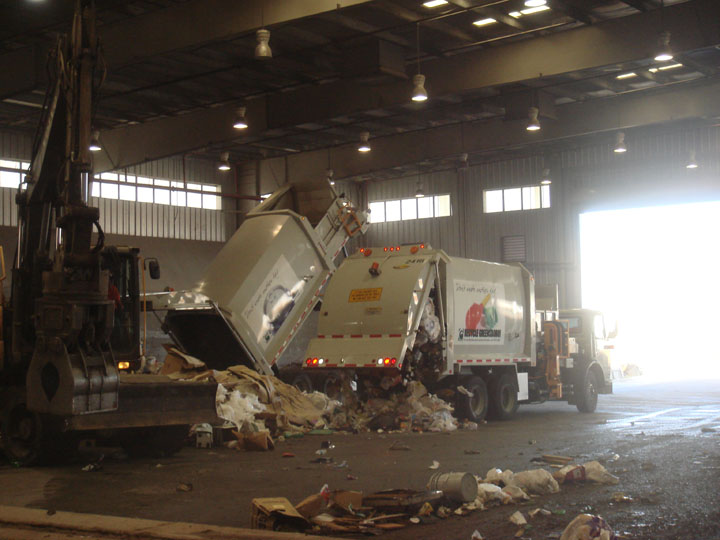Following up on tonight’s trash theme, another quick and quite thorough response, this time from Orange County’s Recycling Programs Manager Robert Taylor.
Early June, with an eye on the impending approval of a new Orange County solid waste transfer facility, I was doing some research on e-waste (electronic waste) management. I already knew Orange County’s residents, the University and businesses have worked hard to reduce, reuse and recycle – and that we’re making good progress towards our goal of %61 waste reduction (see Blair Pollock’s Chapel Hill News column).
In reviewing our county’s waste management plans, I didn’t see an explicit mention of two concerns I had: one, was the county prepared for an onslaught of analog television sets with the Feb. 17th, 2009 switchover to digital (Wired’s Oct. 28th article) and two, what due diligence does Orange County plan to take to validate that the waste facility our solid waste is shipped to will manage e-waste responsibly ( GAO 2008 report detailing U.S. e-waste export travesty [PDF]).
As the transfer site selection process progressed, I had asked the Board of Commissioners consider a site large enough to accommodate additional facilities – like commercial e-waste post-processing operations (E-WasteCenter for instance) that certified their processing complied with the highest available standards. Providing adequate on-site opportunities for these type commercial operations not only makes environmental sense but also offers an economic benefit – jobs.
Here’s my June 1st email:
I’ve been concerned for some time that we’re not handling our county’s e-waste as effectively as we can. Along those lines, are there any special preparations being made to handle the anticipated flood of old style TV’s that might occur with the 2009 switch to HDTV?
Rob’s response was not only thorough but included links for further research.
Hi Will,
Thank you for contacting the recycling program with your concerns.
I understand from your email that you have concerns about the effectiveness of Orange County’s Electronics Recycling Program. Have you experienced a particular difficulty or problem that causes your concern? If you do have a specific concern, it would be helpful to me for you to provide me with some detail so that I can attempt to address your concerns directly.
As a general response to your concern, I will attempt to describe in a broad sense why I believe that our electronics recycling program is quite effective. I will also briefly describe the County’s plans for addressing the potential consequences of the change from analog broadcasting to digital broadcasting that will happen in February 2009.
Orange County began our electronics recycling efforts in the spring of 2002. Since this time our electronics program has experienced significant growth and has also been recognized both regionally and nationally as one of the leading public electronics programs. This is true even when our program is compared to programs operating in states that were early to enact strict electronics recycling legislation such as Massachusetts and California. North Carolina did pass a law last year that requires “computer equipment manufacturers” to develop and implement recycling plans. It is important to note that NC’s legislation specifically excludes televisions, and as such there has been no real leadership on the part of our state to prepare for the transition to digital broadcast. For more information on current state legislation re electronics recycling, please see the National Electronics Recycling Infrastructure Clearinghouse web site: http://www.ecyclingresource.org/ContentPage.aspx?Pageid=28&ParentID=0
Orange County currently accepts all electronic goods and items from Orange County businesses and citizens at no cost. We maintain six public drop-off sites for electronics recycling, and we cooperate with each of our local public works departments (Carrboro, Chapel Hill, and Hillsborough) to enable municipal public works departments to collect from households that choose to work through their municipality’s public works infrastructure, and then deliver that material to our program. Finally, we have a cooperative relationship with the Chapel Hill Carrboro City School System’s PTA Thrift Shops to encourage people who would like to donate their working machines to the Thrift Shops and then in return the electronic materials (computers, monitors, stereos, printers, televisions etc) that are rejected by the Thrift Shop are funneled back into our recycling program.
Our electronics recycling vendor is Synergy Recycling, based in Mayodan NC. Before deciding to work with Synergy, County staff visited, interviewed and audited at least five other vendors. Synergy is ISO 14001 2004 certified, meaning that they have achieved the highest levels of environmental standard for the management of the materials we send them including down-stream audit of the facilities that process and reclaim the commodities that come out of the back-end of the electronics recycling system.
The typical measure used to gauge an electronics recycling program’s success and effectiveness is by measuring diversion (from landfill disposal) in terms of pounds per person per year. By this measure, Orange County’s program is one of the most effective in the nation. Using our program figures from the 2006-2007 Fiscal Year and an estimated population of 121,000 for Orange County, our per-capita diversion for FY 2006-2007 was 5.9 pounds. A more common per-capita diversion rate for a mature electronics recycling program would be on the order of 3.5 lbs per year. Our program continues to improve, and I expect that we will exceed our 5.9 lbs per capita rate for our current fiscal year, FY 2007-2008. I am unaware of any public recycling effort in the nation that exceeds our per-capita diversion rate.
I appreciate your desire to know what Orange County has planned in order to manage the anticipated increase in demand for television recycling that will likely accompany the end of analog broadcast television and the change to digital broadcast.
The Federal Communications Commission has a web site dedicated to providing public information about the transition from analog broadcasting to digital broadcasting. Here is a link to the site: http://www.dtv.gov/index.html
While we have anticipated an increase in the amount of material we will manage, it is my opinion that the transition to digital television will not impact Orange County to the extent that it will impact other communities. I feel this way for three main reasons:
1 – The impending transition to broadcasting only in digital will primarily impact people who watch broadcast television. This means that it will not impact those households who receive their primary television signal through cable or satellite subscription services. Because of the relative affluence of our community, and because of the wide availability of both cable and satellite television service in our area, it will not be necessary for most households to upgrade their television or to purchase a digital-to-analog converter box;
2 – While we have not conducted a scientific survey, I generally believe that many households in Orange County have already purchased televisions that are equipped with internal digital tuners and have already recycled their outdated television sets; and finally
3- Orange County’s electronics recycling program began accepting televisions in the summer of 2003. Since that time we have recycled more than 15,500 end of life televisions. Because of our early commitment to electronics recycling, we already have a robust infrastructure for recycling televisions in place. With this in mind, in order to be ready for the transition to broadcast television we simply need to ensure that our current system is ready for the influx of additional units. In comparison to communities without an active electronics recycling program that accepts televisions, much of the groundwork here has already been completed.
That being said, Orange County is definitely taking several steps to ensure that we are ready for the transition. County staff are preparing language to enable the Board of County Commissioners to add Cathode Ray Tubes (CRTs, the lead-bearing glass picture tube found in televisions and computer monitors) to the items banned from disposal at the Orange County Landfill. If the BOCC approves this proposed ban, it is contemplated that this ban would become effective in January 2008, or about 45 days before the end of analog broadcast. The Department of Solid Waste Management is also preparing to reallocate resources so that there are more staff members available to assist with the handling and processing of the electronics that we receive, and our proposed budget for FY 2008-2009 includes funds to cover the anticipated recycling costs for managing the additional televisions we anticipate receiving.
I hope this information helps address the concerns you raised in your email. I would be glad to answer any specific questions you may have, or to further discuss our electronics recycling program with you. Feel free to email me or to call me at 969-2072.
Sincerely,
Rob
So, the reason for the transfer site omission was straight-forward: Orange County already contracts with Synergy Recycling, a company verified to manage e-waste competently.
Over the years I’ve had the pleasant opportunity to meet folks that quietly and competently perform their job on our community’s behalf.
When I worked at Northern Telecom and, subsequently, as an operating officer at Blast, Inc. (CTO) and Reged.com (CIO/CTO), I liked to present folks that performed beyond their duties a “spot award” as an immediate acknowledgment of a “job well done”. Unfortunately, all I can do here is recognize another effort – like Harv’s – to respond to a citizen’s concern.
Thanks Rob.







